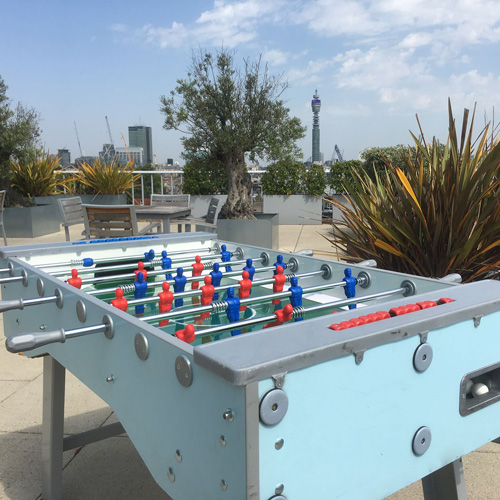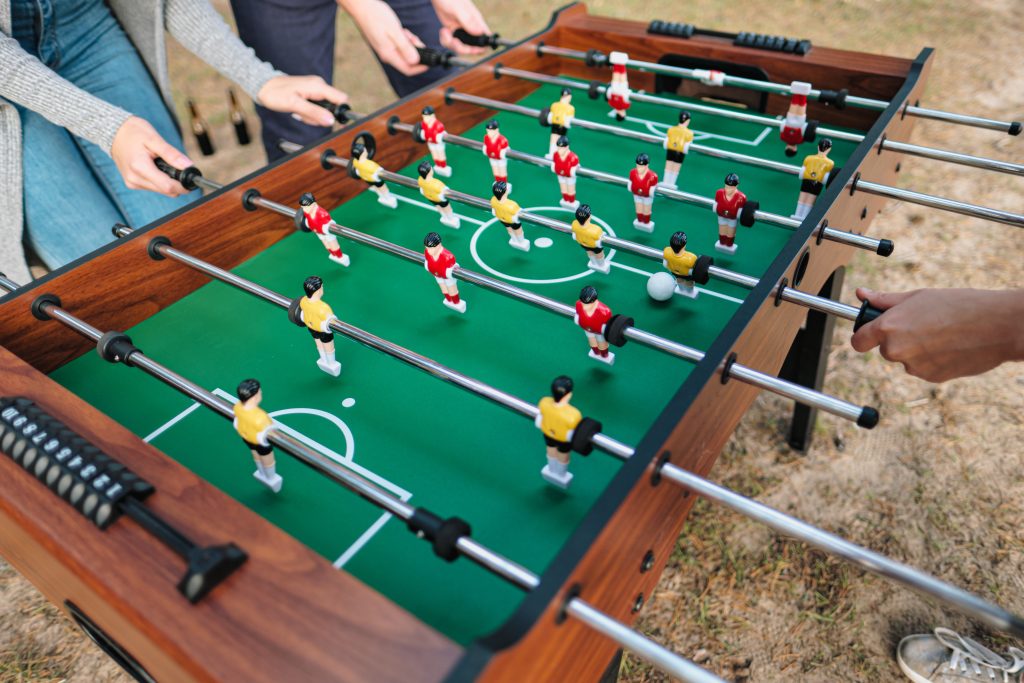
The Origins of a Beloved Pastime
Table football, widely known as foosball in some regions, is a cherished game that has found a place in pubs, arcades, and family game rooms across the globe. Its invention is a tale of creativity and a passion for the beautiful game of football, albeit in a miniaturised form.
The Early Beginnings
The story of table football begins in the early 20th century. While several claims to its invention exist, the most widely acknowledged account credits Harold Searles Thornton, a passionate football fan from the United Kingdom, with the creation of the first basic model in 1921. Harold’s inspiration stemmed from his desire to create a football experience that could be enjoyed in the home, mirroring the excitement of the actual sport. Thornton’s concept was simple yet ingenious. He envisioned a box (the table) with a playing field, complete with miniature players attached to rotating rods. These rods allowed players to control the figures, simulating a football match. The design was rudimentary, but it laid the foundation for what table football would become.


A Global Phenomenon
From these humble beginnings, table football started to spread across Europe and eventually around the world. Different countries adopted and adapted the game, leading to variations in table designs and rules. In France, it’s known as “baby-foot,” while Germans refer to it as “Tischfußball.” The game’s appeal lies in its simplicity and the joy it brings, echoing the fervour of a real football match. Table football tournaments began to spring up, further cementing its status as a competitive sport in its own right.
A Legacy Remembered
Today, Harold Searles Thornton’s invention is more than just a game. It’s a symbol of ingenuity, a testament to the love of football, and a reminder of the simple joys of shared play. Table football continues to evolve, with electronic scoring systems and customised designs, but its heart remains in that original 1921 patent.In every flick of the wrist and twist of a rod, players around the world pay homage to Thornton’s vision, ensuring that the legacy of his invention continues to bring joy and competition to millions.
Patenting the Dream
In 1923, Harold Searles Thornton went on to patent his invention. The patent documentation detailed a game that provided “a football match for two players” which was “particularly amusing and exciting.” The patent, marked with the number GB1920376, became a significant milestone in the game’s history. However, Thornton faced challenges in commercialising his invention. Despite its innovative design, the game didn’t gain immediate popularity, largely due to the lack of marketing and the economic climate of the time.
Spreading Across the Continent
The game’s journey to popularity took a significant turn thanks to Harold’s uncle, Louis P. Thornton, who lived in the United States. Recognising the potential of his nephew’s invention, Louis attempted to market the game in the US, even securing a patent there in 1927. Sadly, like in the UK, the game didn’t take off as expected in the States either. It wasn’t until the 1950s and 1960s that table football began to gain real traction. This surge in popularity is often attributed to Alejandro Finisterre, a Spanish poet and inventor. In 1937, amidst the Spanish Civil War, Finisterre was injured and spent time in a hospital where he dreamt up his version of table football. His design was aimed at children who were unable to play football due to the war. He patented his version in Barcelona, calling it “futbolín.”


The Cultural Impact of Table Football
A Staple in Social Spaces
Table football has transcended its status as a mere game to become a cultural icon, especially in the United Kingdom. You’ll find these tables in various social settings – from the bustling pubs of London to the relaxed cafes in Manchester. Each venue with a table football setup becomes a mini-arena, where friends and strangers alike gather for a quick, spirited game. The clack of the ball and the spinning of rods have become familiar sounds, synonymous with leisure and camaraderie. In these spaces, table football is more than just a game; it’s a social lubricant, breaking down barriers and encouraging interaction. It’s common to see a diverse mix of people, from seasoned players showing off their deft wrist flicks to beginners tentatively spinning the rods, all united by the game.
The Evolution of Design and Technology
Modern Innovations
The design and technology of table football have seen significant advancements since Thornton’s original model. Modern tables boast features like sturdy construction, ergonomic handles, and smooth playing surfaces, enhancing the playing experience. Some high-end models even incorporate electronic systems for automatic scorekeeping and sound effects, bringing a digital edge to the traditional game. The evolution of design also reflects the diverse playing styles across different regions. For instance, Italian tables typically have fast-playing surfaces and lighter players, favouring a quick, skillful style of play. In contrast, German tables are known for their weighted players and grippy surfaces, lending themselves to a more strategic game.
Table Football in Competitive Arenas
A Sport in Its Own Right
What started as a pastime has grown into a competitive sport, with table football championships and leagues around the world. The International Table Soccer Federation (ITSF) governs the sport, organising world championships and maintaining standard rules of play. To find out more about how Viva Vegas have brought the magic of table football back to life in London, contact us today.




